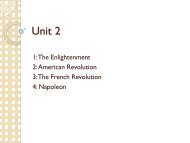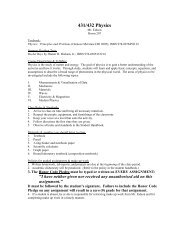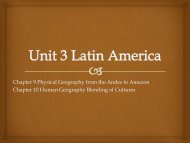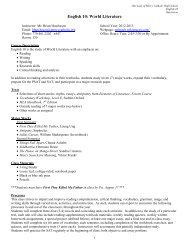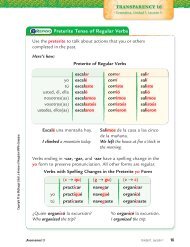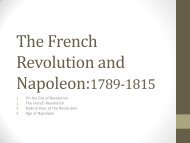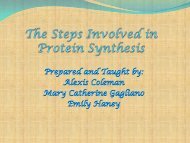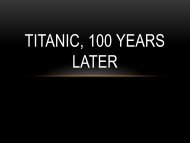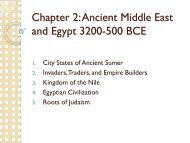The Beginnings of our Global Age: Europe and the Americas
The Beginnings of our Global Age: Europe and the Americas
The Beginnings of our Global Age: Europe and the Americas
- No tags were found...
You also want an ePaper? Increase the reach of your titles
YUMPU automatically turns print PDFs into web optimized ePapers that Google loves.
1492 - 1750
1. Conquest <strong>of</strong> <strong>the</strong> <strong>Americas</strong>2. Spanish <strong>and</strong> Portuguese Colonies in <strong>the</strong> <strong>Americas</strong>3. Struggle for North America4. <strong>The</strong> Atlantic Slave trade5. Effects <strong>of</strong> <strong>Global</strong> Contact
• Conquistador• Immunity• Hernan Cortez• Tenochtitlan• Malinche• Alliance• Moctezuma• Francisco Pizarro• Civil war
• Columbus first encounters <strong>the</strong> Tainos in 1492 when hel<strong>and</strong>s in <strong>the</strong> West Indies• Initially relations are good• Soon relation s<strong>our</strong>ed when <strong>the</strong> Tainos failed to payrespect to <strong>the</strong> Christian symbols <strong>of</strong> <strong>the</strong> Spanish• Columbus thought he was superior to <strong>the</strong> Tainos <strong>and</strong>claimed <strong>the</strong> l<strong>and</strong> for Spain <strong>and</strong> took several prisonersback with him
<strong>The</strong> Tainos PeopleLived in villagesGrew corn <strong>and</strong> yamsWove CottonHad a politicalhierarchyBelieved in life afterdeathWere generous to <strong>the</strong>Spanish
• Follow shortly afterColumbus• Settled on Hispaniola• Greedy for gold <strong>and</strong> l<strong>and</strong>• Forces natives to convertto Christianity
Although <strong>the</strong>y only numbered in <strong>the</strong> hundreds <strong>the</strong>conquistadors were able to conquer <strong>the</strong> natives because<strong>of</strong> three things <strong>the</strong>y had that <strong>the</strong> natives did not.1. Guns2. Horses3. Disease
Cortes Conquers MexicoWealthy L<strong>and</strong> owner from SpainEarly Mexican incursions were repelledby nativesCortes believed he could succeed whereo<strong>the</strong>rs failed1519 l<strong>and</strong>ed with 600 men, 16 horses<strong>and</strong> a few cannonsBurnt his ships to show his men hisdetermination to succede
• As he began his trek inward employed a translatornamed Malinche• Malinche spoke Aztec <strong>and</strong> Mayan <strong>and</strong> learned Spanish• She explained <strong>the</strong> Aztec upon capturing ano<strong>the</strong>rpeople would sacrifice <strong>the</strong>m to <strong>the</strong> Aztec gods• As he moved closer to Tenochtitlan, Cortes usedMalinche to form alliances with people conquered by<strong>the</strong> Aztec
• Aztec believed <strong>the</strong> Spanish were gods fulfilling aprophecy <strong>of</strong> a pale skin bearded man returning toearth thought Cortes was Quetzalcoatl• Moctezuma was not sure if Cortes was a god• Offered gifts but enc<strong>our</strong>aged <strong>the</strong> Spanish to notcontinue to Tenochtitlan• Cortes pressed on not interested in <strong>the</strong> gifts butlooking instead for gold <strong>and</strong> silver
• At first dazzled by <strong>the</strong> gr<strong>and</strong>eur <strong>of</strong> <strong>the</strong> city• Aztec at first welcome <strong>the</strong> Spanish• Soon relations s<strong>our</strong> on difference <strong>of</strong> religious beliefs• Spanish also become greedy for <strong>the</strong> Aztec treasure
• Imprison Moctezuma• Cortes compels Moctezuma to sign a treaty with <strong>the</strong>Spanish• Fighting breaks out between <strong>the</strong> Aztec <strong>and</strong> Spanish• During <strong>the</strong> fight Moctezuma is killed• Spanish are driven from <strong>the</strong> city• Cortes regroups <strong>and</strong> returns <strong>and</strong> conquersTenochtitlan destroying it
• Francisco Pizarro inspired by Cortes• Arrives in Peru in 1532 hearing Incas have more gold thanAztecs• <strong>The</strong> Inca have just resolved a bloody civil war• Atahualpa ruler <strong>of</strong> <strong>the</strong> Incas, meets Pizarro <strong>and</strong> refusesconversion to Christianity• Capture Atahualpa <strong>and</strong> hold him for ransom• Upon receiving <strong>the</strong> ransom, kill Atahualpa• Kill thous<strong>and</strong>s on Inca with superior weapon <strong>and</strong> disease• Soon Spain hold most <strong>of</strong> South America
• Within a few decades a few hundred conqueredmillions with superior weapons, horses, <strong>and</strong> disease• Wealth from <strong>Americas</strong> helps Spain become <strong>the</strong><strong>Europe</strong>'s greatest power• Many natives convert to Christianity
• How did <strong>the</strong> Spanish treat <strong>the</strong> Tainos?• What impact did <strong>the</strong> Aztec’s religious beliefs have onCortes’s approach to Tenochtitlan?• What factors enc<strong>our</strong>aged <strong>the</strong> Spanish in Peru?
• Viceroy• Encomienda• Bartolome de Las Casas• Peon• peninsulare• Creole• Mestizo• Mulatto• Privateer
A flood <strong>of</strong> Spanish settlers <strong>and</strong> missionariesfollowed <strong>the</strong> conquistadors to Spain's new empire.Wherever <strong>the</strong>y went, <strong>the</strong>y established colonies, claiming<strong>the</strong> l<strong>and</strong> <strong>and</strong> its people for <strong>the</strong>ir king <strong>and</strong> Church. When<strong>the</strong>re was resistance, <strong>the</strong> newcomers imposed <strong>the</strong>ir willby force. Over time, however, a new culture emergedthat reflected <strong>Europe</strong>an, Native American <strong>and</strong> Africantraditions.
• Mid 1500’s Spain’s empirestretched from Californiato South America• Spanish divided <strong>the</strong> l<strong>and</strong>into f<strong>our</strong> provincesincluding New Spain <strong>and</strong>Peru• Spain set up <strong>the</strong> Council <strong>of</strong><strong>the</strong> Indies• Governed by Viceroysappointed by <strong>the</strong> king
• Winning souls was asimportant as gainingl<strong>and</strong>• Catholic Church workedwith <strong>the</strong> government toexp<strong>and</strong> in <strong>the</strong> new world• Church leaders served asroyal <strong>of</strong>ficials• Jesuits, Franciscans <strong>and</strong>o<strong>the</strong>r missionariesbaptized thous<strong>and</strong>s
• Spain closely controlledtrade from <strong>the</strong> new world• Colonist could exportraw materials but only bySpanish good in return• Gold <strong>and</strong> Silver were <strong>the</strong>main exports• Sugar Cain became ahuge export
• Granted to <strong>the</strong> conquistadors by <strong>the</strong> SpanishMonarchs• <strong>The</strong> right to dem<strong>and</strong> forced labor form <strong>the</strong> natives inparticular areas• Usually under harsh conditions• Those that resisted were hunted down <strong>and</strong> killed• Often faced disease <strong>and</strong> starvation• Used on plantations <strong>and</strong> in mines
• Bartolome de Las Casas condemned <strong>the</strong> evil ways <strong>of</strong><strong>the</strong> encomienda system• Detailed abuses to <strong>the</strong> king <strong>of</strong> Spain <strong>and</strong> pleaded toend <strong>the</strong> abuse• His efforts resulted in Spain passing laws that forbad<strong>the</strong> use <strong>of</strong> native Americans as slaves• <strong>The</strong>n became Peons, workers forced to work to pay <strong>of</strong>fdebt
• Spanish culture dominated <strong>the</strong> cities• Spanish learned native culture• Building style• Food• <strong>Europe</strong>ans introduced animals like <strong>the</strong> horse• African contributed to culture as well• Farming• Drama• Dance• Song
Higher Class• Peninsulares: Spanishborn. <strong>The</strong>y filled <strong>the</strong>highest positions ingovernment <strong>and</strong> church• Creoles: American bornSpanish descendants,mostly l<strong>and</strong> ownersLower Class• Mestizos nativeAmerican <strong>and</strong> <strong>Europe</strong>anmix• Mulattoes: African <strong>and</strong><strong>Europe</strong>an mix• African – NativeAmerican mix
Lively Town<strong>and</strong> CitiesGenerally lived intowns <strong>and</strong> citiesPopulation grew sorapidly in Mexico itbecame <strong>the</strong> largestSpanish Speaking cityin <strong>the</strong> worldBroad ave. publicmonuments <strong>and</strong>buslting city life
• To meet <strong>the</strong> churches need for educated priestcolonies built universities• University <strong>of</strong> Mexico 1551• Harvard was 1636• Women wanting an education would enter a convent
• 1530 Portuguese encountered <strong>the</strong> Tupian in Brazil <strong>and</strong><strong>the</strong>y were largely wiped out from disease• Portuguese government granted large tracks <strong>of</strong> l<strong>and</strong> toPortuguese nobles• No huge wealth like Spanish• Exported Brazilian wood• Used Native slaves <strong>and</strong> African Slaves to harvest <strong>the</strong>wood
• Used Privateers to disrupt <strong>the</strong> flow <strong>of</strong> gold to Spain• Dutch• French• English
• Francis Drake was born in 1540• Commissioned in 1570 by <strong>the</strong> Queen to sail to Americawith two ships <strong>and</strong> some 70 men• Captured <strong>the</strong> annual mule train carrying Spanish gold<strong>and</strong> silver across <strong>the</strong> isthmus <strong>of</strong> Panama.• Queen could not openly sanction <strong>the</strong> work <strong>of</strong> <strong>the</strong> oneshe called, 'my pirate' after a peace treaty was signedwith Spain• Called <strong>the</strong> Dragon by <strong>the</strong> Spanish
• 1577 sent with five ships to <strong>the</strong> west coast <strong>of</strong> SouthAmerica lost f<strong>our</strong> ships rounding <strong>the</strong> Cape <strong>of</strong> Goodhope• Sacked Valparaiso with only one ship• Captured with one shot <strong>the</strong> Spanish GalleonCacafuego.• Later Circumnavigated <strong>the</strong> world <strong>and</strong> was knighted by<strong>the</strong> Queen <strong>of</strong> Engl<strong>and</strong>• Led Numerous expeditions in Panama to captureSpanish wealth Died at 56 in 1595
• What was <strong>the</strong> Encomienda system?• What was <strong>the</strong> role <strong>of</strong> <strong>the</strong> church in colonial education?• What was brazils economy based on?
In <strong>the</strong> 1600 France, <strong>the</strong> Ne<strong>the</strong>rl<strong>and</strong>s, Engl<strong>and</strong>, <strong>and</strong>Sweden joined Spain in settling North America. NorthAmerica did not yield <strong>the</strong> great pr<strong>of</strong>it or give a waterpassage to Asia however soon <strong>the</strong> English <strong>and</strong> Frenchwere turning large pr<strong>of</strong>its. By <strong>the</strong> 1700’s France <strong>and</strong>Engl<strong>and</strong> controlled large parts <strong>of</strong> North America. <strong>The</strong>ircolonies differed greatly from <strong>the</strong> Spanish in terms <strong>of</strong>language, culture <strong>and</strong> government.
• New France• Revenue• Pilgrims• Fur Trapping• Compact• Jamestown• French <strong>and</strong> Indian War• Treaty <strong>of</strong> Paris
• French fishing shipsharvest a vast amount <strong>of</strong>Cod <strong>of</strong>f <strong>the</strong> coast <strong>of</strong>Newfoundl<strong>and</strong> Canada• Leads to <strong>the</strong> Frenchoccupation <strong>of</strong> nearly half<strong>of</strong> North America• Named claims in CanadaNew France
Jacques Cartier• Was commissioned tosearch for Gold, Silver<strong>and</strong> Spice in NorthAmerica By <strong>the</strong> French• Also to look for a westernpassage• Explored <strong>the</strong> easternCoast <strong>of</strong> Canada• Discovered <strong>the</strong> St.Lawrence River• Claimed much <strong>of</strong>present day Canada for<strong>the</strong> French
• Jesuits followed <strong>the</strong> Explorers into North America• Tried with little success to convert natives• Some lost <strong>the</strong>ir lives, were tortured by <strong>the</strong> natives
• Explores ventured inl<strong>and</strong> with <strong>the</strong> help <strong>of</strong> Native’s• Began to trap <strong>and</strong> trade fur• Fur was sent back to France for a dollar a pelt• Canoes could hold up to 600 pelts• Farming was not very lucrative• Soon <strong>the</strong> Economy <strong>of</strong> New France was mainly derivedfrom Trapping <strong>and</strong> Trading
• French used Revenue from <strong>the</strong> Fur trade to exp<strong>and</strong><strong>the</strong>ir empire• Explored south down <strong>the</strong> Mississippi claiming <strong>the</strong> l<strong>and</strong>to New Orleans naming it Louisiana• Established forts, missions, <strong>and</strong> trading posts• King Louis <strong>the</strong> XIV appointed <strong>of</strong>ficials to oversee <strong>the</strong>happenings <strong>of</strong> New France• French territory exp<strong>and</strong>ed from Quebec to Louisiana
• 1497 John Cabot finds a rich fishing area <strong>of</strong>f <strong>the</strong> coast<strong>of</strong> Newfoundl<strong>and</strong> <strong>and</strong> claims for Engl<strong>and</strong>• Later <strong>the</strong> English continue to explore North Americafor a north west passage• By <strong>the</strong> 1600 Engl<strong>and</strong> is changed its focus toestablishing colonies on <strong>the</strong> Atlantic seaboard in whatis present <strong>the</strong> day United States
• Giovanni Caboto - ItalianNavigator• Commissioned byEngl<strong>and</strong> to ExploreNorth America in 1497• First <strong>Europe</strong>an to exploreNorth America since <strong>the</strong>Vikings• Charted much <strong>of</strong> <strong>the</strong>coast <strong>of</strong> Newfoundl<strong>and</strong><strong>and</strong> Nova Scotia
• English Explorer <strong>and</strong> Navigator• Made two attempts to find a Northwest passage to <strong>the</strong>Pacific• Chartered by <strong>the</strong> English• First trip he explored north looking for a way through<strong>the</strong> ice caps• Second trip looked to go through North America
Hudson’sDiscoveriesHudson RiverDiscovered a straightnamed it Hudsonstraight, led into ahuge bay which henamed Hudson BayCrew mutinied after<strong>the</strong> ship got caught inice <strong>and</strong> set him a driftwith his son <strong>and</strong> afew supporters
• Roanoke – North Carolina• Jamestown - Virginia• Plymouth – Massachusetts
• Two attempts to settle a colony – both failed• First attempt failed because <strong>of</strong> <strong>the</strong> lack <strong>of</strong> supplies• Sir Francis Drake took <strong>the</strong> colonial members with himto Engl<strong>and</strong>• Second attempt ended in mystery• Set up by John White who after establishing returnedto Engl<strong>and</strong> to get supplies <strong>and</strong> was delayed• Three years later he returned to find <strong>the</strong> villageab<strong>and</strong>oned with only <strong>the</strong> word Croataon carved in tree
• Jamestown, Virginia 1607 first permanent colony• Many died from disease <strong>and</strong> starvation• Survivors had help from <strong>the</strong> native Americans• Finally made progress when <strong>the</strong> settlers started togrow <strong>and</strong> harvest tobacco
• Puritans were persecuted for <strong>the</strong>ir beliefs in Engl<strong>and</strong>• Granted a charter to found a colony in <strong>the</strong> New World• <strong>The</strong> “Pilgrims” arrived on <strong>the</strong> Mayflower• Signed <strong>the</strong> “Mayflower Compact”• Established a colony, harsh conditions led to sickness<strong>and</strong> starvation• With <strong>the</strong> help <strong>of</strong> Native Americans were able to survive• Led to wave <strong>of</strong> English Puritans coming to <strong>the</strong> NewWorld established <strong>the</strong> Massachusetts Bay Colony
• 1600 to 1700 English establish more colonies• Virginia <strong>and</strong> New York were commercial ventures• O<strong>the</strong>rs were havens for persecuted religious groups• Pennsylvania - Dutch• O<strong>the</strong>r colonies established to ease <strong>the</strong> over population<strong>of</strong> prisons• Georgia
• English asserted control by appointing governors• Passed Parliamentary law to regulate trade• As opposed from French <strong>and</strong> Spanish, <strong>the</strong> Englishsettlers enjoyed large amounts <strong>of</strong> self-government• Each Colony had its own representative to <strong>the</strong>government elected from property owners• Problem was <strong>the</strong> colonist did not receive all <strong>the</strong> samerights as <strong>the</strong> Englishmen in Engl<strong>and</strong>
• Why did French settlers ab<strong>and</strong>on farming for furtrapping• For what reasons were <strong>the</strong> English colonies established
• Olaudah Equiano• Triangle Trade• Middle Passage• Mutiny
• African slave trade formed part<strong>of</strong> <strong>the</strong> three legged internationaltrade network known as <strong>the</strong>Triangle Trade• Linked Africa to America <strong>and</strong><strong>Europe</strong>• <strong>Europe</strong> to Africa – Rum <strong>and</strong>refined goods, guns• Africa to America - Slaves• America to <strong>Europe</strong> – RawMaterials sugar, cotton, tobacco
• Horrors <strong>of</strong> <strong>the</strong> J<strong>our</strong>ney began before <strong>the</strong>y got on <strong>the</strong>ships• Most captured inl<strong>and</strong> <strong>and</strong> forced to march to <strong>the</strong> coast• Bound with rope <strong>and</strong> chains forces to walk hundreds<strong>of</strong> miles• Some were forced to carry heavy loads• Men most <strong>of</strong> <strong>the</strong> time were bound by iron collarsaround <strong>the</strong>ir necks
• Second Leg <strong>of</strong> <strong>the</strong>Triangle Trade• Slaves transported inhorrendous conditions• Sold as slave in NewWorld to workplantations• Kidnapers <strong>of</strong>ten soldslaves for guns, or o<strong>the</strong>rfinished goods
• Packed into tiny spaces on <strong>the</strong> voyage• Often chained to <strong>the</strong> ship <strong>and</strong> each o<strong>the</strong>r• Voyage could last three months• Many were sick, starved <strong>and</strong> died• Ships called “floating c<strong>of</strong>fins”• Some would Mutiny against <strong>the</strong> crew some wereliberated by pirates• Some committed suicide ra<strong>the</strong>r than be a slave
• Sold into Slavery at age 11 in <strong>the</strong> 1750’s• From a Nigerian village• Transported to <strong>Americas</strong>• Bought first by Michael Pascal, British Navy• Later bought by James King for 40 lbs• Learned to read <strong>and</strong> write <strong>and</strong> later published anautobiography about his life as a slave• Bought his freedom <strong>and</strong> became a author <strong>and</strong> anexplorer in South America• Also an early Abolitionist
America’s• Enormous wealth tomerchants• Colonial economies grewAfrica• Tore communities apart• Lives cut short orbrutalized
• 1500’s about 2000 per year• 1780’s slave trade was at its peak 80,000 per year• By mid 1800’s trade was stopped• Estimated 11 million had reached <strong>the</strong> <strong>Americas</strong>• Estimated 2 million lost <strong>the</strong>ir lives on <strong>the</strong> way
• How did triangular trade effect <strong>the</strong> ColoniesEconomically?• How did enslaved African resist captivity• How did <strong>the</strong> slave trade affect <strong>the</strong> Africans
• Columbian Exchange• Inflation• Price revolution• Capitalism• Entrepreneurship• Mercantilism• tariff
• <strong>The</strong> vast global exchange that resulted in Columbus'svoyage• Variety <strong>of</strong> new foods from <strong>the</strong> new world• Potatoes• Pumpkins• Peppers• Corn• Food was easily transported <strong>and</strong> stored
• Wheat• Grapes• Bananas• Livestock• Cattle• Pigs• Goats• Chickens• Horses <strong>and</strong> donkey’s contribute to transportation
• Transfer <strong>of</strong> food <strong>and</strong> crops enable <strong>the</strong> population togrow• Columbian exchange also enable millions to migrate• <strong>Americas</strong>• Africa• Asia• Slave trade• Some parts <strong>of</strong> <strong>the</strong> world population was replaced dueto disease
• Opening direct links between Asia, Africa <strong>and</strong> <strong>the</strong><strong>Americas</strong> had far reaching effects• <strong>The</strong> Price Revolution• Prices began to rise in <strong>Europe</strong>• Too much money was in circulation• Inflation – <strong>the</strong> increase <strong>of</strong> cost based on moneysavailable• Price revolution• Fuel by <strong>the</strong> enormous amount <strong>of</strong> gold <strong>and</strong> silverflowing into <strong>Europe</strong>
• Economic system where business is privately owned• Owned by Entrepreneurs - <strong>the</strong> people willing to invest<strong>and</strong> take risk in new business• Organized materials• Hired workers• Paid for raw materials <strong>and</strong> transport• Helped change local economies into global tradingempires
• Got accounting from <strong>the</strong> Arabs• Bookkeeping• Pr<strong>of</strong>it <strong>and</strong> loss• Banks increased lending• Joint Stock companies developed• People could pull from <strong>the</strong>ir wealth <strong>and</strong> combine for abusiness venture• Would share in <strong>the</strong> pr<strong>of</strong>its• Loses would only be limited to <strong>the</strong> initial investment
Prices in 1630’s inGuilders• 150 – Average income• 5000 – Still life painting<strong>of</strong> a tulip• 10000- A luxurioushouseSingle Tulip Prices• 10,000 one tulip bulb
• Guilds like unions control <strong>the</strong> manufacture <strong>of</strong> goods• Often small business do not have <strong>the</strong> capital toproduce for a large market• Also had strict rules regulating price <strong>and</strong> cost• Capitalist began to bypass <strong>the</strong> guilds• Began to send materials to o<strong>the</strong>r people to refine• Cottages in small rural towns would weave wool tocloth “cottage industry”
• Mercantilist believed a nations real wealth was in itsgold <strong>and</strong> silver reserves• Oversea colonies existed only to fur<strong>the</strong>r <strong>the</strong> dem<strong>and</strong>s<strong>of</strong> <strong>the</strong> parent country• <strong>The</strong>y supplied raw materials <strong>and</strong> res<strong>our</strong>ces• In return <strong>the</strong> colonies had strict laws governing <strong>the</strong>m• Imposed Tariffs ( taxes) on goods imported
• 1700 divided by class• Merchants – acquired wealth• Nobles – were hurt by revolutions• Skilled workers evolved a middle class• Workers hired by <strong>the</strong> middle class <strong>of</strong>ten lived inpoverty
• What was <strong>the</strong> Columbian Exchange?• Why did <strong>the</strong> population explode?• What was “cottage industry”• What was <strong>the</strong> economic structure <strong>of</strong> <strong>Europe</strong>?



